
A FIRST-TIMER'S NOTES ON THE 2014 TCM CLASSIC FILM FESTIVAL
Mid-day Thursday, April 10, as I waited for my repeatedly delayed flight to depart SFO for Burbank, I had to admit to myself that I'd made a miscalculation in planning my trip to the TCM Classic Film Festival. I'd known for a few days that I would be arriving too late to attend both the Wednesday night "Tweetup" party I'd been invited to and the Press Day event set for Thursday morning. Now I was beginning to wonder whether I'd even arrive in time to check in at the festival press office and be able to attend opening night events.
By the time my plane finally landed and I managed to get to the Roosevelt Hotel, the press office was closed and its staff was down the street working the red carpet. Luckily for me, my contact, a hard-working member of the PR team named Chelsea, came back to the hotel as quickly as she could and signed me in. Armed with badge and goody bag, I was off to the entrance of the Chinese Theatre and got there just as most of the press and spectators were leaving the red carpet area. But Tippi Hedren was as late as I was and so I had a chance to snap a few quick photos of her before she moved on and the carpet was retired for the evening.

Tippi Hedren, April 10, on the red carpet
Soon I was rushing to the screening of Robert Aldrich’s darkest-black comedy, What Ever Happened to Baby Jane? (1962) at the Chinese Multiplex 1. On my way I (almost literally) ran into online friend/blogger Kay Noske but we were headed in different directions and had just moments to say hello. I can tell you, though, that she looked, as I expected, most glamorous.
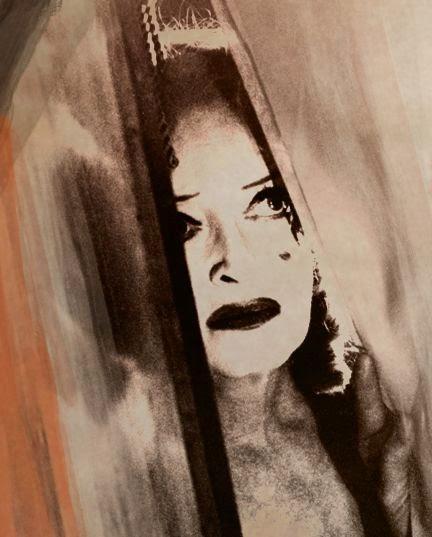
Bette Davis as Jane Hudson
Charles Busch, actor/writer/female impersonator, introduced What Ever Happened to Baby Jane? with a nod to its stature as prototypical ‘Grand Dame Guignol’ and high camp. He also praised Bette Davis, whose turn as Jane is madly flamboyant, for the psychological acuity with which she interpreted the title role. Baby Jane on the big screen is a wild ride, an exaggerated and exciting mix of horror, pathos and outrageous camp. As I watched, I couldn’t help but imagine how much fun Bette must’ve had chewing the scenery as the crazed former child star. Made on a limited budget, Baby Jane was the first American movie to recoup its costs in a single weekend…the weekend following Halloween 1962. And then came the flood of psycho-biddie horror films it inspired (Strait-Jacket, Hush...Hush, Sweet Charlotte, etc.).As Baby Jane approached its grim conclusion it occurred to me that I hadn't eaten a thing since before noon. Because I hadn't had time to check out the eateries at the Hollywood Highland Center or the Roosevelt, I decided it would be easier to grab a bite at my hotel. Dinner and a glass of wine would mark the end of my first day in Hollywood.~ 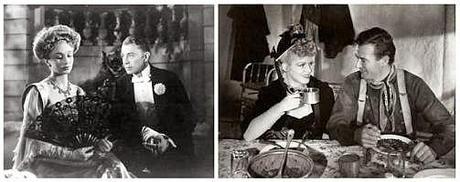
Googie Withers and Clive Brook in On Approval; Claire Trevor and John Wayne in Stagecoach
Friday, festival day two, was the first full day of scheduled events, and the slate was a maze of often difficult choices. I’d committed to seeing one of my all-time favorite films, John Ford’s Stagecoach (1939), in the morning, though I was very curious about On Approval (1944), the only film actor Clive Brook (Marlene Dietrich’s leading man in Shanghai Express) ever directed. Plus, stage legend Beatrice Lillie had co-starred with Brook in On Approval. But I’d never seen Stagecoach on the big screen and couldn’t resist the opportunity.Nancy Schoenberger, author and contributing editor to Vanity Fair, introduced the film. Currently at work on a book about the Ford/Wayne collaboration, she shared anecdotes and backstory on Stagecoach. She reported that Ford had had to fight to cast Wayne as the Ringo Kid because the studio believed the young actor was too much associated with the string of B-movie Westerns he'd been making over the years. And she told us that Wayne admitted to modeling his onscreen persona on the mannerisms and movement of iconic stuntman Yakima Canutt. Canutt performed many stunts for Stagecoach, including one that is the stuff of legend:
Stuntman Vic Armstrong (Raiders of the Lost Ark, Blade Runner) on Yakima Canutt's famous Stagecoach "drop"Though the print wasn't perfect, nothing could lessen the pleasure of seeing John Ford's great classic - with its superb screenplay, photography, editing and performances - on a theater screen with a rapt audience.
Following Stagecoach, I was off to the Hollywood Highland Center to pick up something I’d neglected to bring with me and to GET SOMETHING TO EAT while I had the chance.

Kimberly Truhler with Cybill Shepherd at the 2013 festival
On my way to the Roosevelt to meet someone I’d known online for several years, I spied Kimberly Truhler whose blog, GlamAmor, I follow and whose webinars I've attended. You can’t miss Kimberly – tall and blonde in high heels of a bold primary shade that flawlessly matches her dress - and would recognize without having to ask that she’s worked in fashion and has an affinity for old Hollywood style. We chatted until we were inside the hotel where she turned to go into Club TCM and I entered the lobby to meet my waiting friend.I initially got to know Brandon Goco at TCM’s Classic Film Union, its online fan site, where both of us were blogging a few years ago. He was still in high school and winning awards for his film projects in those days. Brandon participated in my 2012 blog event, A Month of Vertigo, with a video blog on the theme of obsession and has, since then, finished college (as class valedictorian) and started working for the DGA (Directors Guild). Though he missed out on getting a festival pass this year, he was intent on attending the Sunday morning screening of Yasujiro Ozu's Tokyo Story (1953) with a standby ticket. Ozu’s world cinema masterpiece was inspired by Make Way for Tomorrow (1937), which was being shown down the street as Brandon and I spoke.
Next, I crossed the lobby to Club TCM – my first foray into the Roosevelt’s fabled Blossom Room, where the first Academy Awards ceremony was held - to meet another friend.
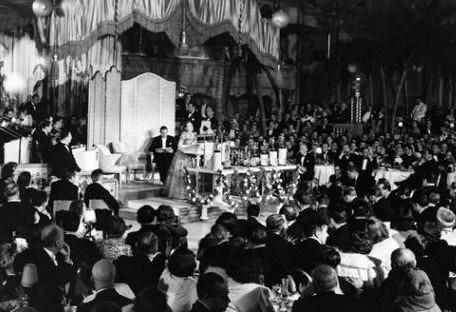
1929 Academy Awards Ceremony in the Blossom Room
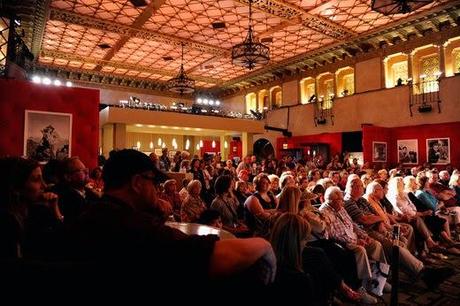
"Club TCM" event in the Blossom Room, April 11, 2014
Christian Esquevin’s website is Silver Screen Modes and he’s the author of Adrian: Silver Screen to Custom Label. We’ve been commenting on each other’s blogs for ages and finally conspired to meet, if only briefly, at Club TCM on Friday. He’d just seen Zulu (1964) and was about to go to the screening of Meet Me in St. Louis (1944). Christian had spent all of Thursday at FIDM (the Fashion Institute of Design & Merchandising) where he delivered his collection of original costume sketches that will be the focus of an exhibit set to open there in June.
By the time Christian left for St. Louis, I’d decided to attend “A Conversation with William Friedkin” at Club TCM. Friedkin has always interested me. He'd been a wunderkind of the New Hollywood, directing two of its classics: The French Connection (1971) and The Exorcist (1973). During the late 1970s he was married to the great French actress, Jeanne Moreau but, by then, his career had begun to falter. Though he suffered serious health problems at one point, he never entirely stopped making movies and has been married to former Paramount CEO, Sherry Lansing, since 1991. Friedkin's most recent films are Bug (2006) with Ashley Judd and Killer Joe (2011) starring Matthew McConaughey. Eddie Muller, founder of the Film Noir Foundation, introduced and interviewed him and it was a spirited, often humorous, exchange that covered the major high and low points of the director's career. The articulate Mr. Friedkin, a great charmer, proved to have enough charisma, brash humor and intelligence to quite easily tuck just about any audience into his back pocket. By the end of the conversation I'd resolved to make a point of seeing his newly restored Sorcerer (1977) Saturday night at the Chinese Theatre.

Eddie Muller, left, and William Friedkin on stage at "Club TCM"
The Friedkin event had run later than scheduled because the Richard Dreyfuss interview before it had gone into overtime. Now it was the dinner hour...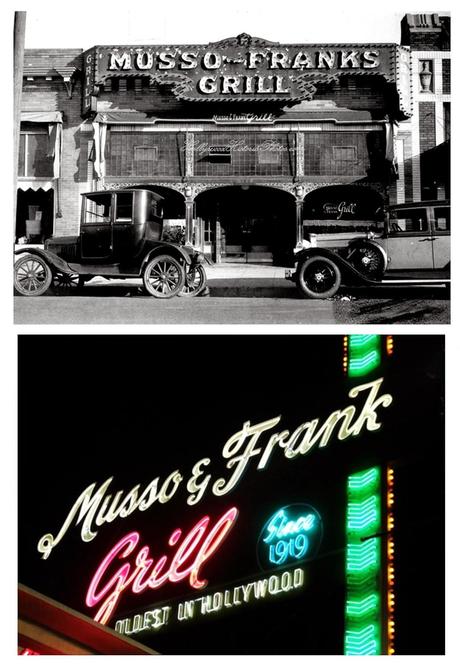
Top and bottom: Musso & Frank's, then and now
Years ago, when I lived in Hollywood for a while, it was during a time when the Walk of Fame area was neglected and seedy. Even so, because I was well aware of its history, I’d taken notice of Musso & Frank’s Grill on Hollywood Boulevard. Though I’d enjoyed a few lunches at the Brown Derby on Vine as well as a dinner or two at Perino’s, I’d never made my way to Musso & Frank’s. On Friday night, that would finally change. A friend and former colleague, who moved from San Francisco to Los Angeles some years ago, was meeting me there for dinner. She lives in the Los Feliz area and works at NBCUniversal but, like me, had yet to dine at the famous Hollywood haunt.
We decided to start with drinks at the bar in the newer (circa 1953) of two rooms that make up the restaurant. As we sipped cocktails and talked, I spotted a number of patrons wearing lanyards with TCM festival badges dangling from them. And as our conversation turned to Hollywood, old and new, visions of the grill’s illustrious guests of days gone by began to dance in my head…Chaplin, Fairbanks, Pickford, Valentino…Barrymore…Garbo…Rita Hayworth…Bogart and Bacall…Marilyn Monroe with Joe DiMaggio…Elizabeth Taylor…Steve McQueen. And the writers who came to town to write for the movies - Fitzgerald, Hemingway, Faulkner, Chandler, Dorothy Parker, John Steinbeck…Kurt Vonnegut. They’d all spent time at Musso & Frank’s.
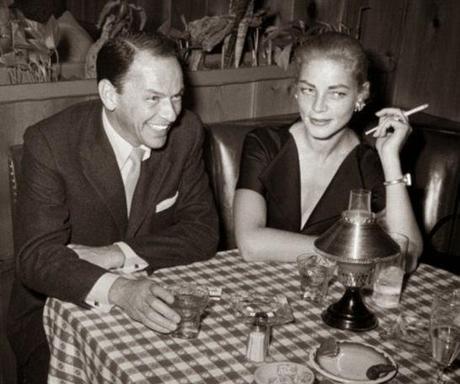
Frank Sinatra and Lauren Bacall at Musso & Frank's in 1957
The place was originally opened by partners Joseph Musso and Frank Toulet and called Frank’s Francois Café. Founded in 1919, the famed grill has witnessed the entire evolution of the movie business in Hollywood, from the silent era to talkies, from mid-century Technicolor epics to today’s CGI extravaganzas.The décor and ambience, like the red bolero-jacketed waiters, are distinctly Old Hollywood. The walls are trimmed and paneled in dark wood, the upholstery is red Naughahide and muted pastoral-themed scenes decorate the wallpaper. Most affecting of all, though, is the intimacy one feels with the Hollywood history that seems to saturate Musso & Frank’s. Oh yes, and the food is good, too.
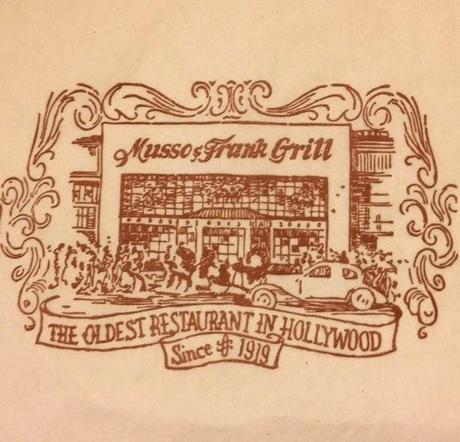
...to be continued...

